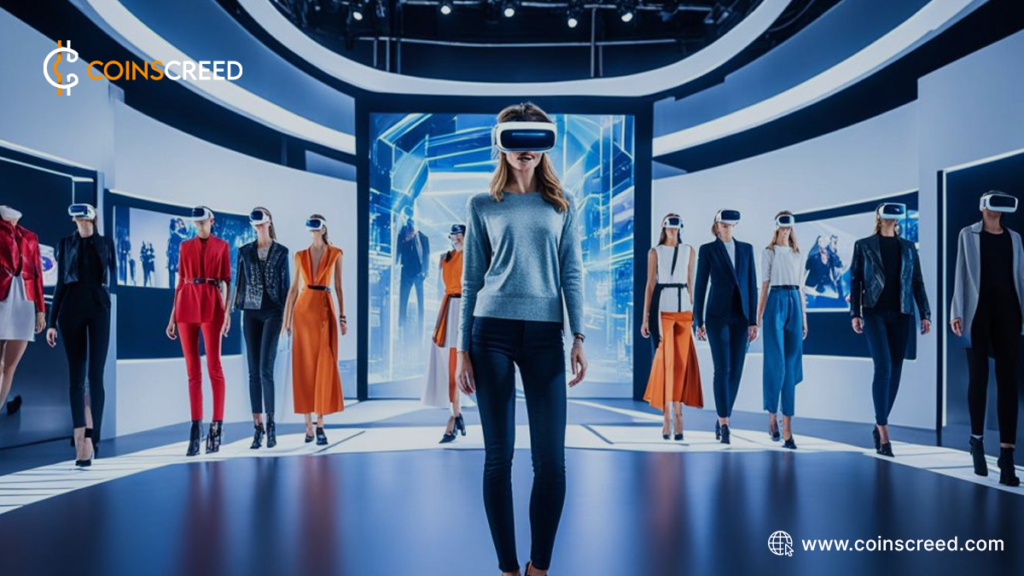The new age of fashion is here! Join us as we delve into virtual fashion shows and digital fittings—everything about the new age of retail.

The fashion world is undergoing a revolutionary development, with traditional runways giving way to a dynamic and futuristic counterpart: the virtual fashion show.
As technology continues to permeate every aspect of our lives, the fashion industry, recognized for its innovative spirit, has embraced the digital realm to revolutionize how we experience and engage with haute couture.
In the not-too-distant past, the catwalks of Paris, Milan, and New York were the sacred grounds where designers debuted their works to a select audience of industry insiders, celebrities, and fashion enthusiasts.
However, the terrain changed, and a new era was upon us. Virtual fashion shows, held in the immersive worlds of the digital universe, have emerged as the cutting-edge platform for showcasing the most recent trends and collections.
The appeal of virtual fashion shows stems not only from their accessibility but also from the creative opportunities they provide to designers.
Beyond the confines of physical spaces, the digital sphere serves as a canvas for creativity, experimentation, and pushing the limits of traditional fashion presentations.
This metamorphosis initiates a fascinating dialogue between fashion and technology, resulting in experiences that transcend the boundaries of the physical world.
The Evolution of Fashion Shows
Fashion shows, formerly reserved for the affluent, have evolved with time from private displays to vast spectacles that captivate worldwide audiences.
Origins of Fashion Shows
Fashion shows date back to the mid-nineteenth century in Paris, when designers would exhibit their works to a limited audience. These private showings were held in ateliers, laying the groundwork for the runway spectacle we know today.
Rise of Haute Couture
In the early twentieth century, haute couture houses were established in Paris, cementing the significance of fashion shows as the prime forum for revealing high-end creations.
Pioneering designers such as Paul Poiret and Coco Chanel saw the runway as a method to showcase their artistic ideals to a larger audience.
Postwar Era and Golden Age
Fashion displays were more accessible after World War II. Events such as New York Fashion Week emerged, highlighting American designers globally.
The runways grew, and the audience expanded beyond industry insiders to include journalists, celebrities, and fashion lovers.
The digital revolution
Fast forward to the late twentieth century, when the introduction of technology caused a seismic shift in the fashion world.
The internet revolutionized how people consumed fashion, with online platforms providing real-time coverage of runway shows. This internet exposure cleared the path for a more diverse, globally engaged audience.
The Rise of Virtual Fashion Shows
The rise of virtual fashion shows puts the fashion industry on the verge of a significant leap in the twenty-first century.
A combination of issues, including the need for sustainability, the Impact of the COVID-19 epidemic, and the drive for creativity, has prompted designers to investigate digital runways as a viable alternative to traditional displays.
Importance of Virtual Fashion Shows
As the fashion business moves into the digital age, virtual fashion shows have become a game-changing platform, providing designers with a dynamic canvas to rethink the art of presentation.
Some advantages of virtual fashion shows include;
- Global accessibility
- Cost-effective production
- Creative freedom and innovation
- Inclusion and diversity
- Reduced environmental Impact
Global Accessibility
One of the most significant advantages of virtual fashion shows is the democratization of access. No longer limited to exclusive venues in fashion capitals, these digital runways break down geographical constraints, offering a global audience to experience the spectacle in real-time.
Cost-effective Production
Traditional fashion shows can come with high fees for venue leasing, set construction, and logistics. Virtual fashion shows offer a low-cost alternative, allowing designers to utilize their resources better.
Creative freedom and innovation
The digital arena provides unprecedented creative freedom, allowing designers to experiment with new display methods.
From immersive 3D landscapes to interactive features, virtual fashion shows have become a playground for pushing the limits of traditional runway presentations.
Inclusion and Diversity
Virtual fashion shows create a more inclusive industry by accepting varied voices and ideas. Designers can cast more models, reflecting different nationalities, body kinds, and backgrounds.
Reduced environmental Impact
As sustainability becomes increasingly important in fashion, virtual displays provide a greener alternative. Virtual runways minimize the carbon footprint of traditional events by removing the need for actual travel, set construction, and excessive production.
Virtual fashion shows provide designers with not only a venue to showcase their ideas but also a transforming place that amplifies their voices on a worldwide scale.
The New Age of Retail
In the ever-changing fashion industry, designers navigate the internet sphere with innovation, reinventing classic creative methods for the virtual stage. Some features of the new age of retail are;
- Digital lookbooks
- 3D fashion design and prototyping
- Digital fitting room
- Immersive 3D fashion shows
Digital lookbooks
Designers are moving away from traditional printed lookbooks and toward dynamic digital versions.
Digital lookbooks provide an immersive and interactive experience, enabling designers to present their collections in a visually appealing and easily shareable format.
3D Fashion Design and Prototyping
The introduction of 3D fashion design software has transformed how designers conceptualize and bring their works to reality. Designers can use digital platforms to build detailed and realistic 3D prototypes, providing a virtual canvas for experimenting with textures, colors, and patterns.
Digital Fitting Rooms
As the digital and real worlds converge, virtual fitting rooms have emerged as a significant changer in the online buying experience. Designers use augmented reality (AR) and virtual reality (VR) technologies to let buyers virtually try on apparel before purchasing.
Immersive 3D Fashion Shows
In the lack of real runways, designers use immersive 3D fashion displays to attract viewers.
These digital showcases surpass the restrictions of traditional catwalks, allowing designers to build virtual surroundings that match and enhance the concept of their collections.
The New Age of Retail: Influence on Virtual Fashion
Introducing virtual fashion shows represents an important turning point in fashion marketing, causing a ripple effect beyond traditional techniques.
Global Reach and Accessibility
Virtual fashion shows break down physical barriers, making fashion a global concern. Brands may now contact audiences across continents in real-time, creating a sense of inclusivity and broadening their market reach.
Enhanced Engagement with Social Media
Social media platforms are a dynamic venue for virtual fashion presentations, fostering a solid synergy between designers and their audiences.
Live streaming on sites like Instagram, YouTube, and TikTok provides consumers with real-time access and immediate involvement through likes, comments, and shares.
Storytelling and Brand Narratives
Virtual fashion shows turn into immersive storytelling experiences rather than just garment demonstrations.
Brands use the digital stage to tell stories beyond the runway, giving audiences insight into the inspiration, craftsmanship, and ideals that distinguish their collections.
Influencer Collaborations
With their reach and clout among niche audiences, influencers play an important role in marketing virtual fashion events. Collaborations with influencers provide a sense of authenticity and relatability to the digital runway.
Challenges of Virtual Fashion Shows
While virtual fashion shows have brought about a new era of creativity and accessibility, they have also presented obstacles and critics.
Loss of Tangibility and Sensory Experience
One of the main issues critics raise is the loss of the tactile and sensual experience that conventional fashion presentations provide.
The lack of the tactile feel of materials, the sound of footsteps on the runway, and the in-person atmosphere leave a hole that virtual encounters struggle to fill.
Sustainability and Environmental Concerns
While virtual fashion shows are frequently marketed as more ecologically friendly due to reduced travel and physical manufacturing, some say the digital arena is not eco-conscious.
The energy consumption involved with streaming, the carbon footprint of data centers, and the electrical waste generated by digital devices used to watch shows all represent sustainability concerns that must be addressed.
Digital fatigue and oversaturation
The rise of digital information, particularly virtual fashion shows, has raised concerns about digital fatigue and saturation. Audiences overwhelmed with online events and content may feel decreased enthusiasm and participation.
Accessibility Barriers
While virtual fashion shows strive to improve accessibility, several limitations remain. Not everyone has equal access to high-speed internet, cutting-edge technology, or immersive VR experiences.
Security and Intellectual Property Issues
As virtual fashion shows rely significantly on digital technologies, security and intellectual property questions have arisen.
Issues such as unauthorized use of digital assets, the protection of original designs, and the possibility of cyber threats present problems for the fashion sector in the virtual realm.
Conclusion
As the fashion industry continues to explore virtual realms, navigating these obstacles will require a deliberate and adaptable approach.
As designers, customers, and industry experts cope with these issues, the conversation around virtual fashion shows continues to expand, influencing the future path of this dynamic junction of fashion and technology.
The metaverse has great revolutionary potential, and as fashion businesses begin on this digital journey, it promises to reshape how we perceive style and connect and express ourselves in this dynamic and ever-changing digital environment.
The future of fashion is inextricably linked to the metaverse, and the industry’s capacity to embrace and negotiate this transformational landscape will create its story in the years ahead.
